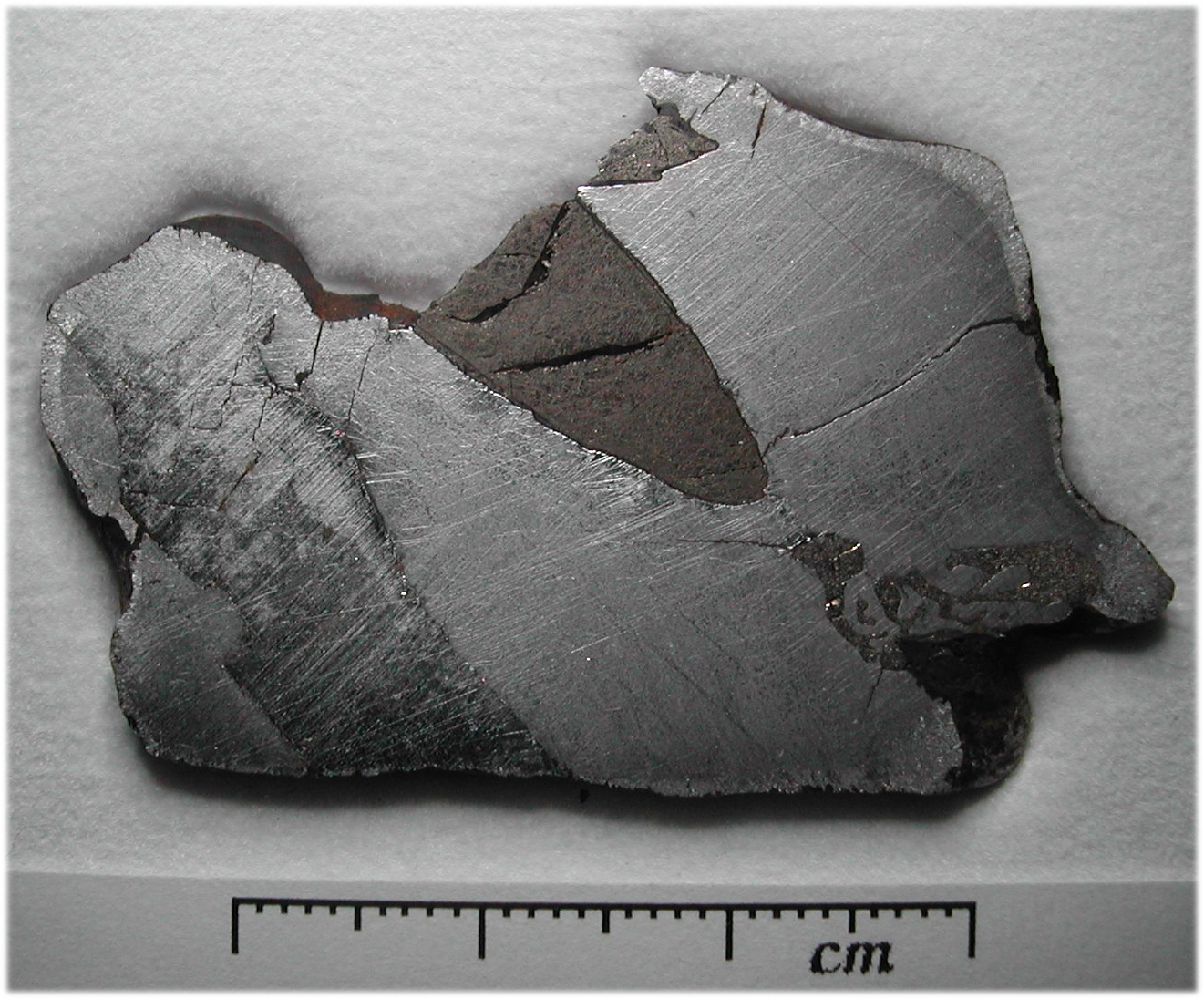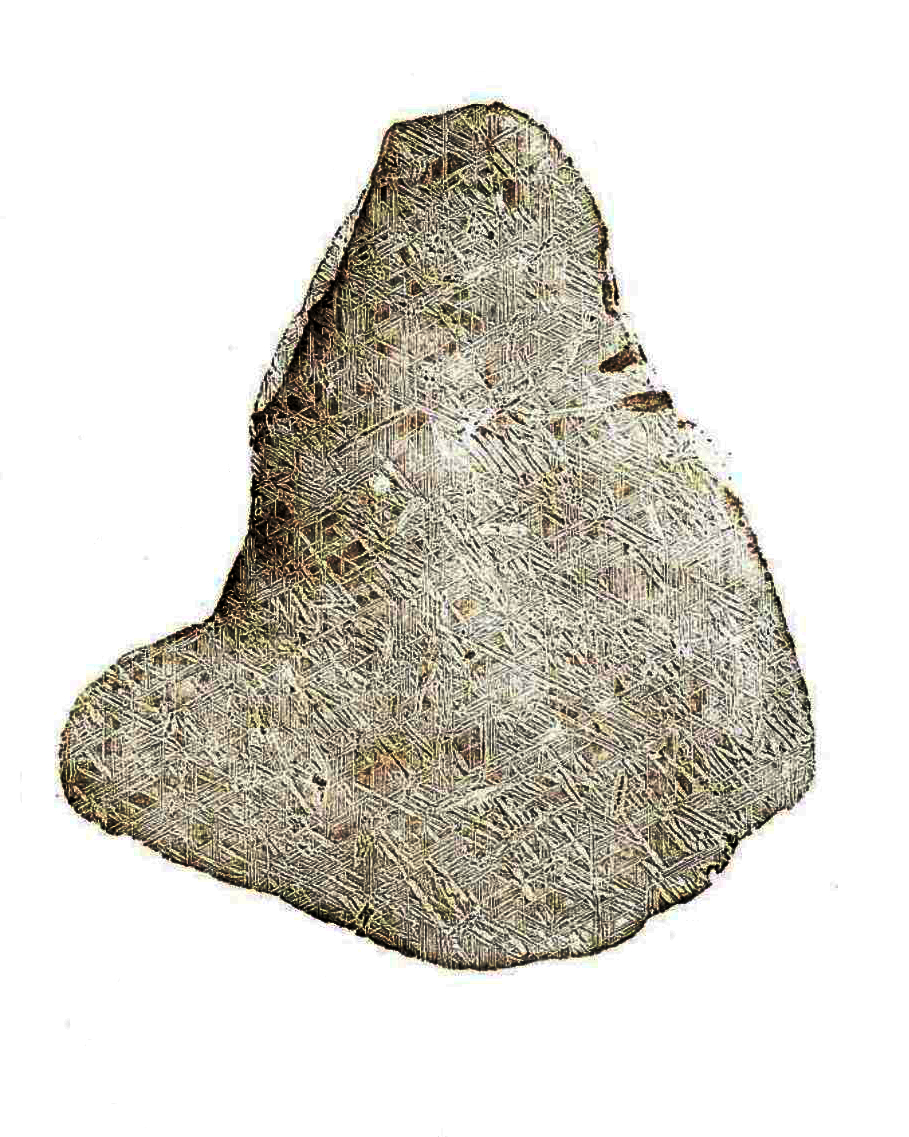|
Kamacite
Kamacite is an alloy of iron and nickel, which is found on Earth only in meteorites. According to the International Mineralogical Association (IMA) it is considered a proper nickel-rich variety of the mineral native iron. The proportion iron:nickel is between 90%:10% and 95%:5%; small quantities of other elements, such as cobalt or carbon may also be present. The mineral has a metallic luster, is gray and has no clear cleavage although its crystal structure is isometric-hexoctahedral. Its density is about 8 g/cm3 and its hardness is 4 on the Mohs scale. It is also sometimes called balkeneisen. The name was coined in 1861 and is derived from the Greek root ''καμακ-'' "kamak" or ''κάμαξ'' "kamaks", meaning vine-pole. It is a major constituent of iron meteorites (octahedrite and hexahedrite types). In the octahedrites it is found in bands interleaving with taenite forming Widmanstätten patterns. In hexahedrites, fine parallel lines called Neumann lines are often ... [...More Info...] [...Related Items...] OR: [Wikipedia] [Google] [Baidu] |
Nickel
Nickel is a chemical element with symbol Ni and atomic number 28. It is a silvery-white lustrous metal with a slight golden tinge. Nickel is a hard and ductile transition metal. Pure nickel is chemically reactive but large pieces are slow to react with air under standard conditions because a passivation layer of nickel oxide forms on the surface that prevents further corrosion. Even so, pure native nickel is found in Earth's crust only in tiny amounts, usually in ultramafic rocks, and in the interiors of larger nickel–iron meteorites that were not exposed to oxygen when outside Earth's atmosphere. Meteoric nickel is found in combination with iron, a reflection of the origin of those elements as major end products of supernova nucleosynthesis. An iron–nickel mixture is thought to compose Earth's outer and inner cores. Use of nickel (as natural meteoric nickel–iron alloy) has been traced as far back as 3500 BCE. Nickel was first isolated and classified as an e ... [...More Info...] [...Related Items...] OR: [Wikipedia] [Google] [Baidu] |
Taenite
Taenite is a mineral found naturally on Earth mostly in iron meteorites. It is an alloy of iron and nickel, with a chemical formula of and nickel proportions of 20% up to 65%. The name is derived from the Greek ταινία for "band, ribbon". Taenite is a major constituent of iron meteorites. In octahedrites it is found in bands interleaving with kamacite forming Widmanstätten patterns, whereas in ataxites it is the dominant constituent. In octahedrites a fine intermixture with kamacite can occur, which is called plessite. Taenite is one of four known Fe-Ni meteorite minerals: The others are kamacite, tetrataenite, and antitaenite. Properties It is opaque with a metallic grayish to white color. The structure is isometric-hexoctahedral ( cubic). Its density is around 8 g/cm3 and hardness is 5 to 5.5 on the Mohs scale. Taenite is magnetic, in contrast to antitaenite. The structure is isometric-hexoctahedral ( cubic). The crystal lattice has the c≈a= 3.582±0.002 Å ... [...More Info...] [...Related Items...] OR: [Wikipedia] [Google] [Baidu] |
Hexahedrite
Hexahedrites are a structural class of iron meteorite. They are composed almost exclusively of the nickel–iron alloy kamacite and are lower in nickel content than the octahedrites. The nickel concentration in hexahedrites is always below 5.8% and only rarely below 5.3%. The name comes from the cubic (i.e. ''hexahedron'') structure of the kamacite crystal. After etching, hexahedrites do not display a Widmanstätten pattern, but they often do show Neumann lines: parallel lines that cross each other at various angles, and are indicative of impact shock on the parent body. These lines are named after Johann G. Neumann, who discovered them in 1848. Chemical classification Concentrations of trace elements (germanium, gallium and iridium) are used to separate the iron meteorites into chemical classes, which correspond to separate asteroid parent bodies. Chemical classes that include hexahedrites are: * IIAB meteorites (includes also some octahedrites) * IIG meteorites See also * Glos ... [...More Info...] [...Related Items...] OR: [Wikipedia] [Google] [Baidu] |
Octahedrite
Octahedrites are the most common structural class of iron meteorites. The structures occur because the meteoric iron has a certain nickel concentration that leads to the exsolution of kamacite out of taenite while cooling. Structure Octahedrites derive their name from the crystal structure paralleling an octahedron. Opposite faces are parallel so, although an octahedron has 8 faces, there are only 4 sets of kamacite plates. Due to a long cooling time in the interior of the parent asteroids, these alloys have crystallized into intermixed millimeter-sized bands (from about 0.2 mm to 5 cm). When polished and acid etched the classic Widmanstätten patterns of intersecting lines of lamellar kamacite, are visible. In gaps between the kamacite and taenite lamellae, a fine-grained mixture called plessite is often found. An iron nickel phosphide, schreibersite, is present in most nickel-iron meteorites, as well as an iron-nickel-cobalt carbide, cohenite. Graphite and troili ... [...More Info...] [...Related Items...] OR: [Wikipedia] [Google] [Baidu] |
William Thomson (mineralogist)
William Thomson (1760 – November 1806) was an English mineralogist, who used the name Guglielmo Thomson in Italy in later life. He died in Palermo at the age of 46 years.Gian Battista Vai, W. Glen E. Caldwell. ''The origins of geology in Italy''. Geological Society of America, 2006, . –p. 184/ref> Discovery of Widmanstätten pattern Thomson at the time was living in Naples. One day he decided to treat a sample of the Krasnojarsk meteorite with nitric acid for the purpose of cleaning it of rust. Shortly after the contact with acid he noticed on the surface of the metal a strange never seen before figures: it was the later-called Widmanstätten pattern. In 1804, his discovery was published in the ''Bibliothèque Britannique'', in French.F. A. Paneth. ''The discovery and earliest reproductions of the Widmanstatten figures''. Geochimica et Cosmochimica Acta, 1960, 18, pp. 176–182 After his death, his work was published in 1808 in Italian (translated from the original English ... [...More Info...] [...Related Items...] OR: [Wikipedia] [Google] [Baidu] |
Neumann Line
Neumann lines, or Neumann bands, are fine patterns of parallel lines seen in cross-sections of many hexahedrite iron meteorites in the kamacite phase, although they may appear also in octahedrites provided the kamacite phase is about 30 micrometres wide. They can be seen after a polished meteorite cross-section is treated with acid. The lines are indicative of a shock-induced deformation of the kamacite crystal, and are thought to be due to impact events on the parent body of the meteorite. The lines are named after Johann G. Neumann, who discovered them in 1848 in the iron meteorite Braunau, a hexahedrite, which fell in 1847.J. G. Burke: Cosmic Debris, Meteorites in History. University of California Press, 1986. See also * Glossary of meteoritics *Widmanstätten pattern Widmanstätten patterns, also known as Thomson structures, are figures of long nickel–iron crystals, found in the octahedrite iron meteorites and some pallasites. They consist of a fine interleaving o ... [...More Info...] [...Related Items...] OR: [Wikipedia] [Google] [Baidu] |
Plessite
Plessite is a meteorite texture consisting of a fine-grained mixture of the minerals kamacite and taenite found in the octahedrite iron meteorites. It occurs in gaps (its name is derived from the Greek "plythos" meaning "filling"according tMindat a mineral database and mineralogical reference website) between the larger bands of kamacite and taenite which form Widmanstätten patterns. Many types of plessite exist and vary in formation mechanism and morphology. Some types of plessite as named by Buchwald's "Iron Meteorites" and Massalski's "Speculations about Plessite" are: *acicular or type I plessite *black or type II plessite *cellular or type III plessite *comb plessite *net plessite *pearlitic plessite *spheroidized plessite See also * Glossary of meteoritics This is a glossary of terms used in meteoritics, the science of meteorites. # * 2 Pallas – an asteroid from the asteroid belt and one of the likely parent bodies of the CR meteorites. * 4 Vesta – second-larg ... [...More Info...] [...Related Items...] OR: [Wikipedia] [Google] [Baidu] |
Thomson Structures
Thomson may refer to: Names * Thomson (surname), a list of people with this name and a description of its origin * Thomson baronets, four baronetcies created for persons with the surname Thomson Businesses and organizations * SGS-Thomson Microelectronics, a electronics manufacturer * Various travel subsidiaries of TUI Group: ** Thomson Airways (now TUI Airways), a UK-based airline ** Thomson Cruises (now Marella Cruises), a UK-based cruise line ** Thomson Holidays (now TUI UK), a UK-based travel company ** Thomsonfly, a former UK airline, formerly Britannia Airways *Thomson Directories, local business search company and publisher of: **Thomson Local, the UK business directory *Thomson Multimedia, former name of Technicolor SA, a French multinational corporation * Thomson Reuters, Canadian media and information services company ** Thomson Corporation, former name of the company prior to its 2008 merger with Reuters ** Thomson Financial, former business division of Thomson ** T ... [...More Info...] [...Related Items...] OR: [Wikipedia] [Google] [Baidu] |
Widmanstätten Pattern
Widmanstätten patterns, also known as Thomson structures, are figures of long nickel–iron crystals, found in the octahedrite iron meteorites and some pallasites. They consist of a fine interleaving of kamacite and taenite bands or ribbons called ''lamellae''. Commonly, in gaps between the lamellae, a fine-grained mixture of kamacite and taenite called plessite can be found. Widmanstätten patterns describe features in modern steels, titanium, and zirconium alloys. Discovery In 1808, these figures were observed by Count Alois von Beckh Widmanstätten, the director of the Imperial Porcelain works in Vienna. While flame heating iron meteorites, Widmanstätten noticed color and luster zone differentiation as the various iron alloys oxidized at different rates. He did not publish his findings, claiming them only via oral communication with his colleagues. The discovery was acknowledged by Carl von Schreibers, director of the Vienna Mineral and Zoology Cabinet, who named the ... [...More Info...] [...Related Items...] OR: [Wikipedia] [Google] [Baidu] |
Nitric Acid
Nitric acid is the inorganic compound with the formula . It is a highly corrosive mineral acid. The compound is colorless, but older samples tend to be yellow cast due to decomposition into oxides of nitrogen. Most commercially available nitric acid has a concentration of 68% in water. When the solution contains more than 86% , it is referred to as ''fuming nitric acid''. Depending on the amount of nitrogen dioxide present, fuming nitric acid is further characterized as red fuming nitric acid at concentrations above 86%, or white fuming nitric acid at concentrations above 95%. Nitric acid is the primary reagent used for nitration – the addition of a nitro group, typically to an organic molecule. While some resulting nitro compounds are shock- and thermally-sensitive explosives, a few are stable enough to be used in munitions and demolition, while others are still more stable and used as pigments in inks and dyes. Nitric acid is also commonly used as a strong oxidizing agen ... [...More Info...] [...Related Items...] OR: [Wikipedia] [Google] [Baidu] |
Alois Von Beck Widmanstätten
Count Alois von Beckh Widmanstätten (13 July 1754 – 10 June 1849) was an Austrian printer and mineralogist. His name is sometimes given as Alois von Beckh-Widmannstätten or Aloys Joseph Franz Xaver Beck Edler von Widmanstätten. He is known for recognizing a unique pattern of cross-hatching lines on the surface of iron-rich meteorites, now called Widmanstätten pattern, Widmanstätten patterns, resulting from the cooling and crystallization of interstitial minerals. A crater on the moon is named after Widmannstätten (crater), Widmanstätten. Working life Von Widmanstätten was born in Graz where his family had a printing business and was trained in the printing art by his father. His family owned exclusive printing rights in the Steiermark province, but this was lost in 1784 and Alois sold the business in 1807. In 1804, he ran a spinning mill in Pottendorf, Austria. In 1806 he was invited by the emperor to head a newly founded Imperial Technical Museum or ''Fabriksprodukt ... [...More Info...] [...Related Items...] OR: [Wikipedia] [Google] [Baidu] |





